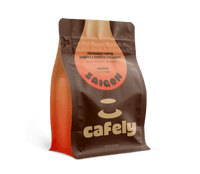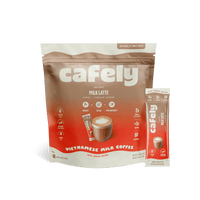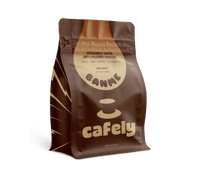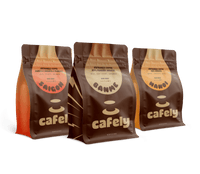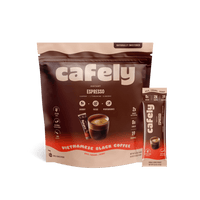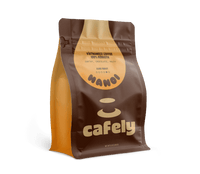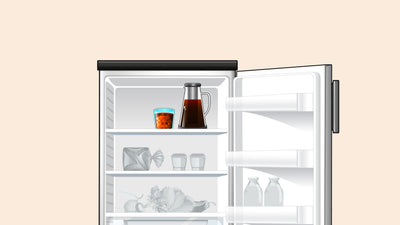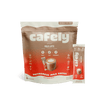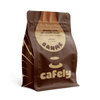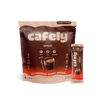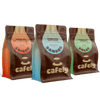We've all experienced stale and bitter coffee at one point or another. So, how do we ensure our coffee stays at its best and most flavorful?
We'll explain the shelf life of different coffee types, from whole beans to instant, and give you the best storage tips to help your coffee last longer.
Types of Coffee & Their Shelf Life
Not all coffee remains fresh for the same amount of time. The type of coffee you have will affect how long it remains at its best.
1. Brewed Coffee
Once you've made your coffee, you have a limited amount of time before it loses its aroma, flavor, and freshness. Ideally, you should drink it within a few hours of brewing or keep it in the fridge for up to 3-4 days.
Just make sure to cool down coffee quickly before storing it in the fridge.
2. Ground Coffee
The grinding process exposes the oils and other essential components of the coffee beans, so you’ll only have a limited amount of time before it loses its oomph.
Ground coffee is at its optimal freshness for about 1-2 weeks, after which you might notice a dip in flavor or quality.
3. Whole Coffee Beans
So long as you store them right, whole beans will last longer than ground coffee, remaining at their best for 3-4 weeks.
To extend your coffee’s life, grind your beans when you need them and only as much as you need to make sure the rest stays fresh.
4. Instant Coffee
Instant coffee is the longest-lasting of all the coffee types, although many might argue it’s the worst in terms of quality overall (we beg to differ).
Freeze-dried or spray-dried coffee will last for years unopened, but a general rule of thumb is to use it within a few months once you crack that seal.
What Factors Affect Coffee’s Shelf Life?

It’s not just the type and form of the coffee that affects how long it will be at its best — there are other factors to look out for. Heat, air, light, and moisture can all have an effect on your coffee if you don’t store it properly.
Moisture
One of the biggest risks to your coffee’s freshness and shelf life is moisture. Coffee is particularly good at absorbing moisture. If water is allowed to creep in or it is kept in a humid environment, the coffee will take this on, resulting in its flavor and aroma breaking down.
Wet or humid conditions can also create perfect conditions for mold to grow, which will render the coffee completely unusable. If you find that this happens frequently to your coffee, you should probably reconsider where and what you store your coffee in.
UV Light
Light will also impact your coffee beans through a process called photodegradation. Exposure to light will start to break down the fats, proteins, vitamins, and the color of your coffee. All types of light can cause this, but sunlight is the worst offender.
If you have your coffee beans on display in a glass jar, you might want to consider opting for an opaque container.
Oxygen
Exposing your coffee to the air or leaving it unsealed will also mean a swift drop in your coffee’s freshness. This is due to oxidization, where the oxygen breaks down the coffee molecules, starting to strip away things like the sugars and acids that help to make the perfect cup. Although it’s pretty much impossible to remove the effect of oxygen entirely, an airtight container can minimize its effects.
Heat
Ideally, keep the coffee in a cool place. Heat speeds up chemical processes, including decomposition. It’s one of the reasons we put stuff in the fridge to keep it from going bad quickly (don’t put your coffee in there, though). A cool place, like in a cupboard or away from heat sources like your oven and stovetop, will do just fine.
What's the Best Container in which to Store Coffee?
The best way to store your coffee is in an opaque, airtight container. Most of the best containers on the market are made from metal like aluminum, and they range from simple designs with rubber interior seals to block out air and moisture to more high-tech versions with vacuum sealing technology.
Picking the right container isn't enough, though — think carefully about where you place it in your kitchen. Avoid sources of heat — windowsills or near stovetops, air fryers, and other appliances that get hot — and keep it away from strong light, both natural and artificial. Ideally, the best place to put your coffee container is in a cool, dark cupboard.
What About the Freezer?
You may sit there thinking: “If I need to keep my coffee cool and away from the light, why don't I put it in my freezer?” But, we’re here to tell you that it’s a far from ideal way to store your beans.
Freezing your beans means that they then need to be thawed, which can leave them susceptible to absorbing moisture and condensation due to their porous nature. Water content from other items in your freezer can also leech onto your coffee, affecting its flavor and aroma.
Desiccants & Vacuum-Sealing
Moisture might be hard to avoid if you live in a humid climate. If this is the case for your situation, consider investing in moisture-absorbing packets and adding them to your coffee container. Alternatively, vacuum seal your coffee beans in batches to keep them protected against oxygen and humidity.
Signs of Stale Coffee

If you think your coffee might be past its prime, here are 5 ways to tell if your coffee has gone stale:
- Give it a smell — Fresh coffee will fill your kitchen with its aromas when ground. If you notice that your coffee doesn’t really smell like anything when you grind it, it’s most likely gone stale.
- Feel the texture of your grind — If your coffee is still good, you should be able to feel some moisture and a slight oiliness when you rub the grounds between your fingers, and they may clump a little. Stale coffee, on the other hand, will be dry and not stick to each other at all, almost like coarse sand or dry soil.
- Look at the brew — A good coffee should easily form a crema or bloom depending upon the brewing method you’re using. If your coffee doesn’t perform in this way, it could mean that it is stale.
- Give it a taste — Fresh coffee should be full of flavor and aroma. On the other hand, stale coffee has a flat taste and may be more bitter-tasting.
- Check the packaging — Although it is not the best way to confirm if your coffee is stale, checking the packet for the roasting date or a best-before date can help you understand when it will be past its best.
While it’s not harmful to drink stale coffee, it’s definitely not the best experience you can have. You’ll be missing out on the full flavors, aromas, and quality of your brew like the rich nuts, citrus, and maple syrup in our DaNang blend.
If you see mold on your beans, you should throw them away as, at this point, they are past stale — they're spoiled, and there's no saving these beans.
Pro Tips for Keeping Your Coffee Fresh
Alongside proper storage, here are some of our top tips to keep your coffee fresher for longer.
- Buy coffee that you know is freshly roasted — At Cafely, we always freshly roast each batch to order to ensure you get the freshest beans.
- Store your coffee properly — keep your coffee in an opaque, airtight container, and in a cool, dark place.
- Grind just before you brew — Once the coffee is ground, it starts to lose its oils much quicker, while whole beans last a bit longer. If you drink a lot of coffee or don't want to hassle with grinding it each time, pregrind smaller amounts and store the grounds in a sealed container.
- Don’t buy too much — Although it can seem tempting, you should only really try to buy enough coffee to last you for around a week at a time. This ensures that the coffee you get is fresh each week and, hopefully, freshly roasted, too.
What to Do With Spent or Stale Beans
If your coffee has gone stale, don’t throw it out right away. There are still some ways to use your old beans.
- Make your own coffee liqueur using brewed coffee, sugar syrup, and a neutral spirit like vodka.
- Create chocolate-covered coffee beans to use as garnishes and decorations.
- Use it to make a coffee-flavored dessert, such as coffee cake, coffee ice cream, or tiramisu.
- Perk up your plants and keep slugs and snails away by spreading ground coffee on top of the soil.
FAQs: How Long Does Coffee Last?

Still want to know more about the lifespan of your coffee, or how to keep it fresh? We’ve got you covered.
1: Can I still drink coffee after its best-by date?
It is perfectly fine and safe to drink coffee once it has gone past its best-by or best-before date. However, you’ll find that it lacks in flavor and freshness, and could have more bitter notes to it as the oils and flavor compounds have degraded.
2: Is it safe to freeze coffee beans?
Freezing coffee beans will make them last longer, but it does come with a few caveats. For example, it could let moisture in either from the storage or the thawing process, which will sap the flavor and aroma of the beans.
3: How can I tell if my brewed coffee is still good?
Freshly brewed coffee should behave in the way you expect it to — espresso should have a good crema, and you should get a good bloom with a phin filter, Aeropress brewer, or French press. If all else fails, usually the smell and flavor will let you know as stale coffee tends to have a flat taste and scent compared to top-quality beans.
4: Does the type of coffee roast affect its shelf life?
Darker roasts like our SaiGon OG tend to degrade a bit quicker than lighter ones, but it’s not by a substantial amount. So long as you are storing your coffee properly you won’t really notice a difference.
Related: Butter Coffee Recipe
5: What is the best way to store coffee in a humid climate?
The main goal is to keep moisture out, so an airtight container is ideal when kept in a cool, dark place. You can also buy packets of desiccants to put into your coffee container. These are designed to suck up moisture and keep it away from your beans. Additionally, a dehumidifier will help with food storage in general, including your coffee.
Use airtight containers and consider a dehumidifier for storage areas.
6: How often should I replace my coffee supply?
This depends on how much coffee you get through. Ideally, for the freshest coffee, you should try to resupply every week, although every few weeks is completely fine too. If you want to save time and ensure you always have enough on hand, it might be worth considering where to buy bulk coffee and knowing how to store it properly to maintain freshness.
Related: Where to Buy Authentic Vietnamese Coffee (A Buyer's Guide)
7: Are there any coffee types that last longer than others?
Instant coffee generally has the longest shelf life due to its low moisture content. However, if it’s not your thing, then whole coffee beans are the next best alternative, staying fresh for 3-4 weeks so long as you store them properly.
8: Can old coffee make you sick?
It’s very unlikely that stale coffee will make you sick, although the taste can be slightly unpleasant. However, if the coffee smells off, or has developed mold, it’s best to throw it away.
9: How does grinding affect coffee's shelf life?
When you grind coffee, you expose it even further to the air, as well as releasing oils containing flavor and aroma. From this point, the clock is ticking if you want to keep your coffee fresh, so it's best to grind just before brewing.
10: What are the best containers for storing coffee?
Containers that are opaque and airtight are the best for storing your coffee. There are lots of options out there to choose from, but just make sure they meet these criteria before you buy.
